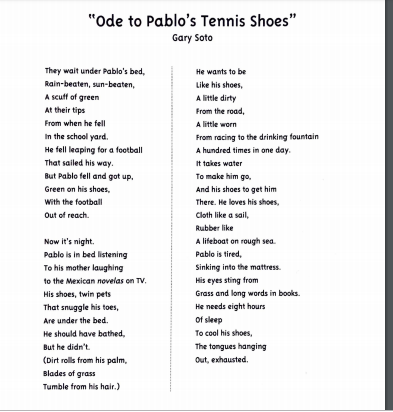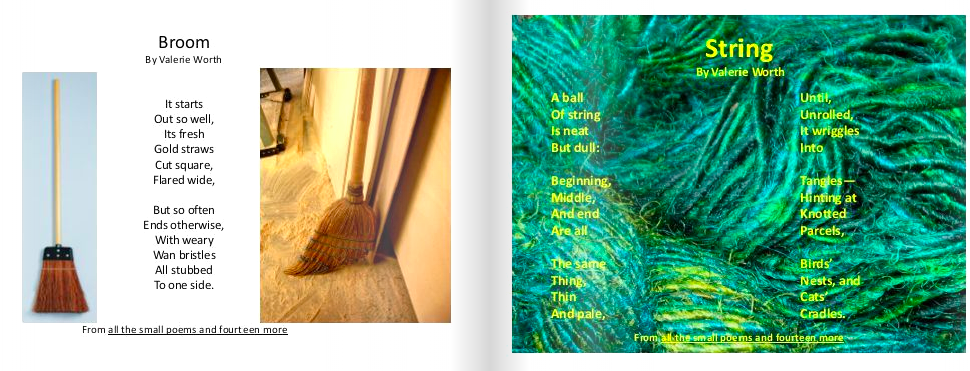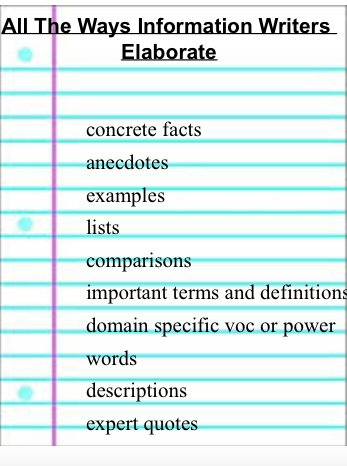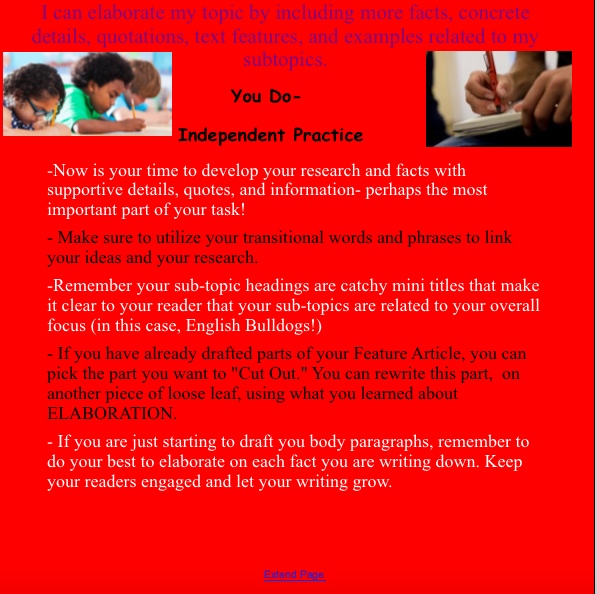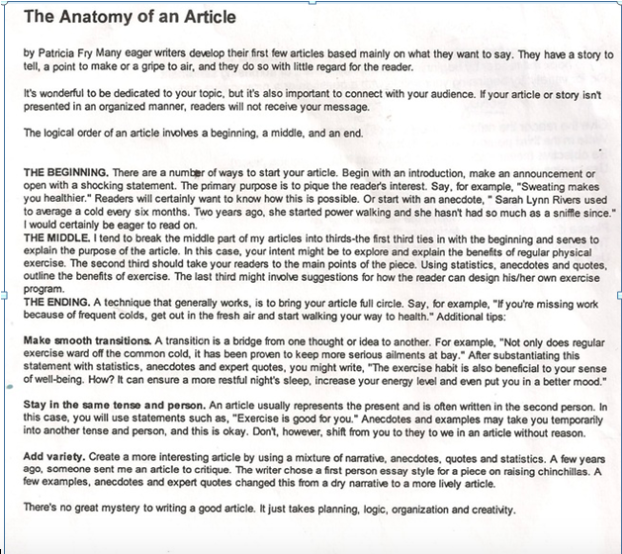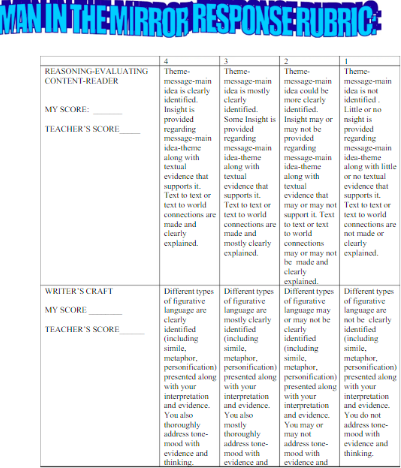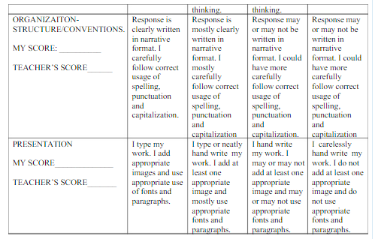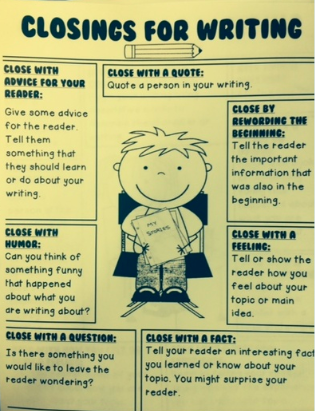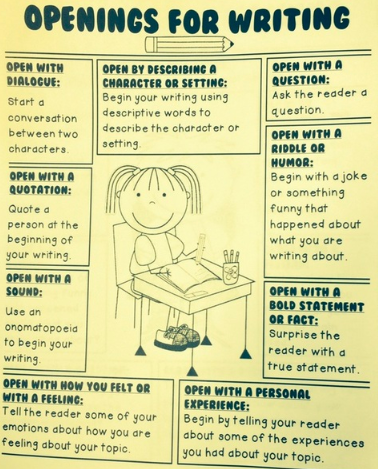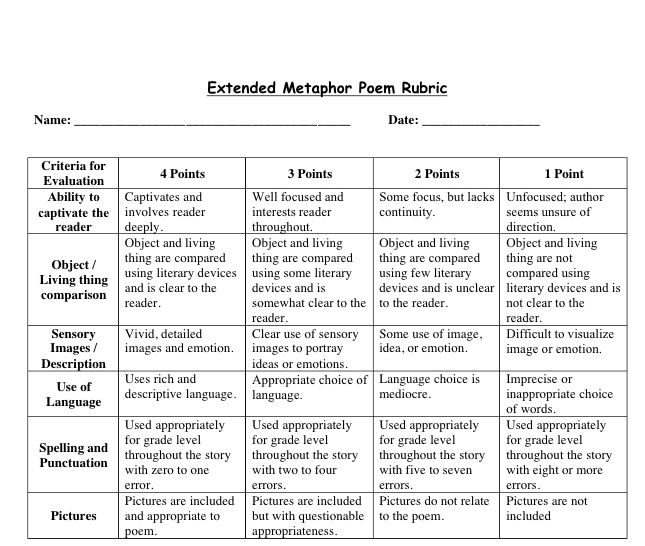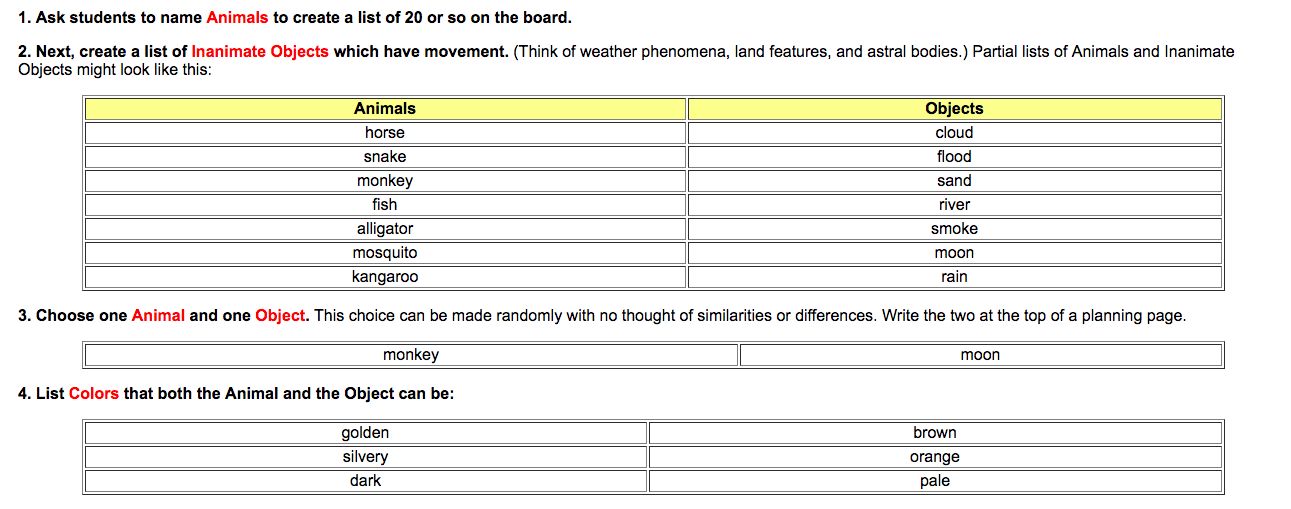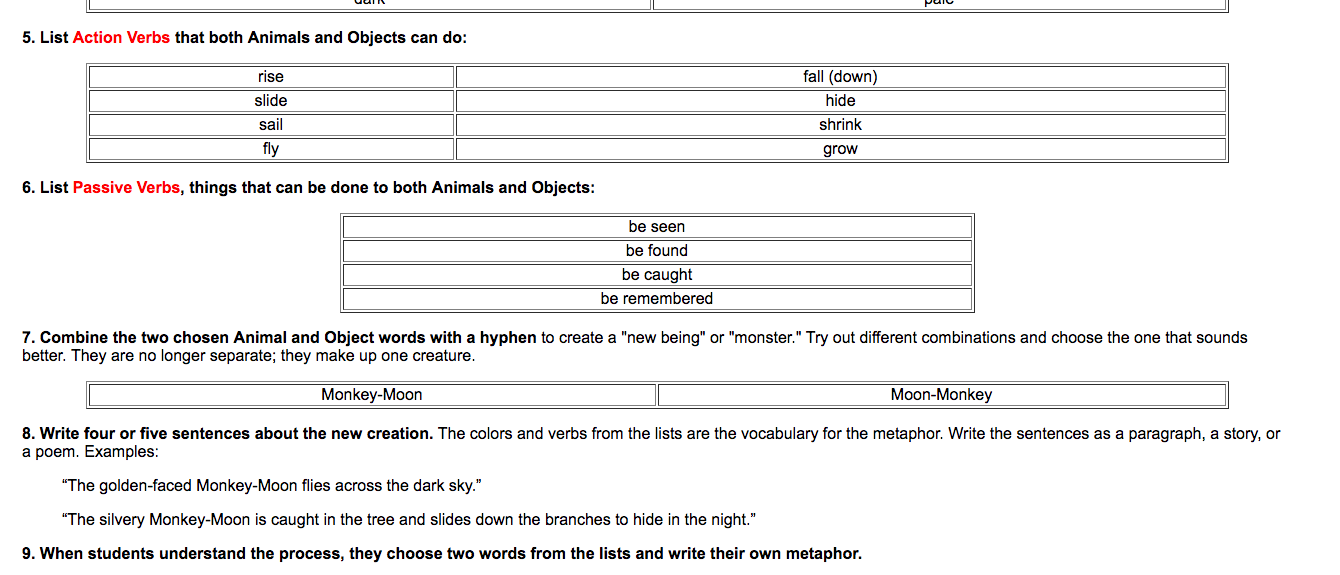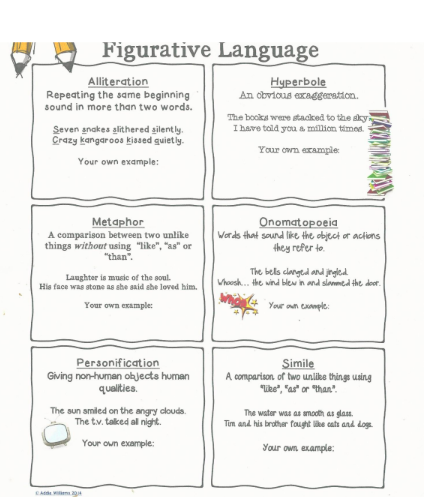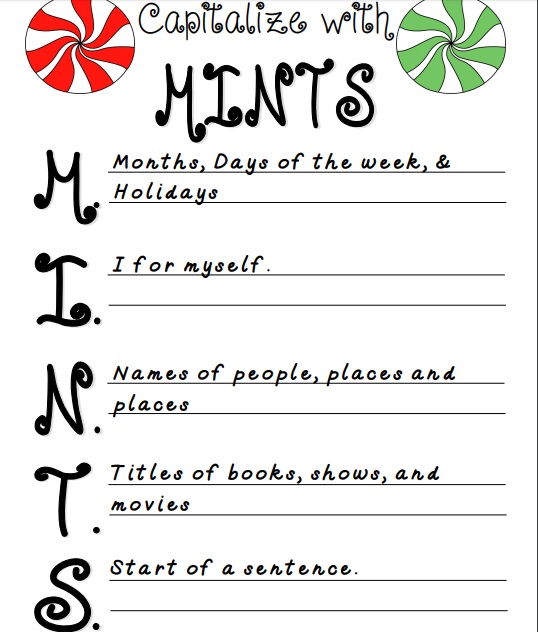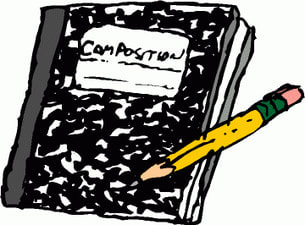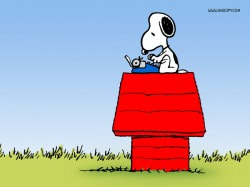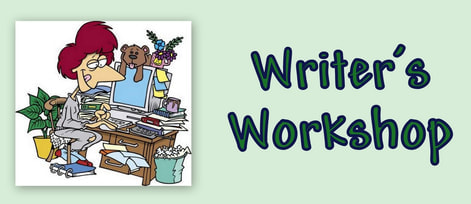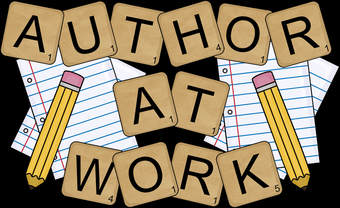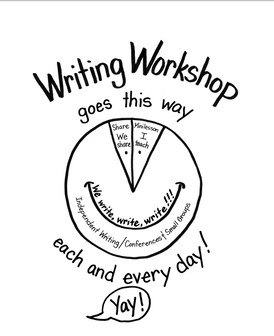In fifth grade, students learn how to conduct research using primary sources, how to write narratives that are reflective and theme-based, and how to write argument essays that use counterargument to clarify a position. Students are asked to deliberately use their knowledge of narrative craft to make their stories more thematic. Students draw inspiration and understanding from mentor texts, historical accounts, primary source documents, maps, and timelines to write focused research reports that engage and teach readers. Students grasp that form follows content, learning to take insights about their lives and decide whether these are best expressed in narratives, in essays, or in a hybrid genre created especially to convey the writer’s content. Fifth-graders learn to build powerful arguments that convincingly balance evidence and analysis to persuade readers to action.
POETRY ANTHOLOGY: PLEASE ADD AT LEAST ONE LETTER POEM TO YOUR ANTHOLOGY
| _poetry_anthology_rubric.docx | |
| File Size: | 18 kb |
| File Type: | docx |
| poetry_anthology-due_thursday_june_13th.docx | |
| File Size: | 560 kb |
| File Type: | docx |
ACROSTIC POETRY:
| acrostics.pdf | |
| File Size: | 1073 kb |
| File Type: | |
| _acrostic_poetry_rubric.docx | |
| File Size: | 16 kb |
| File Type: | docx |
SILLY LIMERICKS (AABBA):
| limericks.pdf | |
| File Size: | 1696 kb |
| File Type: | |
POWERFUL POETRY PRESENTATION:
| poetry-powerpoint-my-favorite__2_.ppt | |
| File Size: | 1846 kb |
| File Type: | ppt |
ODES: CELEBRATING THE EXTRAORDINARY IN ORDINARY PEOPLE, PLACES AND THINGS
I can create an ode by celebrating a seemingly ordinary everyday person, place or thing with descriptive and figurative language.
LINK TO RUBRIC: washington.dbqschools.org/wp-content/uploads/sites/18/2015/12/ode-rubric.pdf
- Just get emotional. What really makes you emotional, either in a positive or negative way? Think of a person, concept, place or thing that you are deeply connected to. This will be a potential topic for your ode. Remember, an ode is focused on the many nuances of a single thing, so make sure that whatever you pick is something that you feel strongly about, so you have enough to write.
- If you feel something, say something. When someone brings up the thing you have chosen to write about in conversation, how do you react? Write down what you would say in such a situation, and even more importantly, how you would (or do) feel. You may end up needing many words that have the same definition or meaning, so checking out a thesaurus can be hugely useful.
- Size matters. How long do you want your poem to be? Odes are traditionally very long, and chances are, if you’ve picked a topic you really feel passionately about, you will have a lot to write. Start by splitting up your poem into groups, or stanzas, of ten lines. Many traditional odes have three to five of these stanzas, but if you want to write more, by all means do!
- To rhyme or not to rhyme? Do you want your poem to rhyme? Most odes do, and making your ode rhyme would be a fun challenge, but you can also write irregular odes, which don't have to rhyme or maintain a perfect rhythm. If you do decide to make your ode rhyme, think about how you want to format the rhyme scheme of this poem. You can make every two lines or every other line rhyme. A certain kind of popular ode uses a more complicated pattern. You can also make up your own pattern -- just commit to it, and use it in every stanza of your ode.
- Share your poem! If your ode is written about a particular person, you could give it to them as a gift. You can recite your ode, or put it to music and sing it. Don't forget to share it with your class community -- post your ode so we know what matters to you!
- AND....Don't forget that your options for how you might create or change an ode are pretty infinite.
ODE TO BILLY JOE (SONG)
Ode to Billie Joe
Bobbie Gentry
It was the third of June, another sleepy, dusty Delta day
I was out choppin' cotton, and my brother was balin' hay
And at dinner time we stopped and walked back to the house to eat
And mama hollered out the back door, y'all, remember to wipe your feet
And then she said, I got some news this mornin' from Choctaw Ridge
Today, Billy Joe MacAllister jumped off the Tallahatchie Bridge
And papa said to mama, as he passed around the blackeyed peas
Well, Billy Joe never had a lick of sense; pass the biscuits, please
There's five more acres in the lower forty I've got to plow
And mama said it was shame about Billy Joe, anyhow
Seems like nothin' ever comes to no good up on Choctaw Ridge
And now Billy Joe MacAllister's jumped off the Tallahatchie Bridge
And brother said he recollected when he, and Tom, and Billie Joe
Put a frog down my back at the Carroll County picture show
And wasn't I talkin' to him after church last Sunday night?
I'll have another piece-a apple pie; you know, it don't seem right
I saw him at the sawmill yesterday on Choctaw Ridge
And now ya tell me Billie Joe's jumped off the Tallahatchie Bridge
And mama said to me, child, what's happened to your appetite?
I've been cookin' all morning, and you haven't touched a single bite
That nice young preacher, Brother Taylor, dropped by today
Said he'd be pleased to have dinner on Sunday, oh, by the way
He said he saw a girl that looked a lot like you up on Choctaw Ridge
And she and Billy Joe was throwing somethin' off the Tallahatchie Bridge
A year has come and gone since we heard the news 'bout Billy Joe
And brother married Becky Thompson; they bought a store in Tupelo
There was a virus going 'round; papa caught it, and he died last spring
And now mama doesn't seem to want to do much of anything
And me, I spend a lot of time pickin' flowers up on Choctaw Ridge
And drop them into the muddy water off the Tallahatchie Bridge
Bobbie Gentry
It was the third of June, another sleepy, dusty Delta day
I was out choppin' cotton, and my brother was balin' hay
And at dinner time we stopped and walked back to the house to eat
And mama hollered out the back door, y'all, remember to wipe your feet
And then she said, I got some news this mornin' from Choctaw Ridge
Today, Billy Joe MacAllister jumped off the Tallahatchie Bridge
And papa said to mama, as he passed around the blackeyed peas
Well, Billy Joe never had a lick of sense; pass the biscuits, please
There's five more acres in the lower forty I've got to plow
And mama said it was shame about Billy Joe, anyhow
Seems like nothin' ever comes to no good up on Choctaw Ridge
And now Billy Joe MacAllister's jumped off the Tallahatchie Bridge
And brother said he recollected when he, and Tom, and Billie Joe
Put a frog down my back at the Carroll County picture show
And wasn't I talkin' to him after church last Sunday night?
I'll have another piece-a apple pie; you know, it don't seem right
I saw him at the sawmill yesterday on Choctaw Ridge
And now ya tell me Billie Joe's jumped off the Tallahatchie Bridge
And mama said to me, child, what's happened to your appetite?
I've been cookin' all morning, and you haven't touched a single bite
That nice young preacher, Brother Taylor, dropped by today
Said he'd be pleased to have dinner on Sunday, oh, by the way
He said he saw a girl that looked a lot like you up on Choctaw Ridge
And she and Billy Joe was throwing somethin' off the Tallahatchie Bridge
A year has come and gone since we heard the news 'bout Billy Joe
And brother married Becky Thompson; they bought a store in Tupelo
There was a virus going 'round; papa caught it, and he died last spring
And now mama doesn't seem to want to do much of anything
And me, I spend a lot of time pickin' flowers up on Choctaw Ridge
And drop them into the muddy water off the Tallahatchie Bridge
FAMOUS ODE: Ode to a Nightingale
BY JOHN KEATS
My heart aches, and a drowsy numbness pains
My sense, as though of hemlock I had drunk,
Or emptied some dull opiate to the drains
One minute past, and Lethe-wards had sunk:
'Tis not through envy of thy happy lot,
But being too happy in thine happiness,—
That thou, light-winged Dryad of the trees
In some melodious plot
Of beechen green, and shadows numberless,
Singest of summer in full-throated ease.
O, for a draught of vintage! that hath been
Cool'd a long age in the deep-delved earth,
Tasting of Flora and the country green,
Dance, and Provençal song, and sunburnt mirth!
O for a beaker full of the warm South,
Full of the true, the blushful Hippocrene,
With beaded bubbles winking at the brim,
And purple-stained mouth;
That I might drink, and leave the world unseen,
And with thee fade away into the forest dim:
Fade far away, dissolve, and quite forget
What thou among the leaves hast never known,
The weariness, the fever, and the fret
Here, where men sit and hear each other groan;
Where palsy shakes a few, sad, last gray hairs,
Where youth grows pale, and spectre-thin, and dies;
Where but to think is to be full of sorrow
And leaden-eyed despairs,
Where Beauty cannot keep her lustrous eyes,
Or new Love pine at them beyond to-morrow.
Away! away! for I will fly to thee,
Not charioted by Bacchus and his pards,
But on the viewless wings of Poesy,
Though the dull brain perplexes and retards:
Already with thee! tender is the night,
And haply the Queen-Moon is on her throne,
Cluster'd around by all her starry Fays;
But here there is no light,
Save what from heaven is with the breezes blown
Through verdurous glooms and winding mossy ways.
I cannot see what flowers are at my feet,
Nor what soft incense hangs upon the boughs,
But, in embalmed darkness, guess each sweet
Wherewith the seasonable month endows
The grass, the thicket, and the fruit-tree wild;
White hawthorn, and the pastoral eglantine;
Fast fading violets cover'd up in leaves;
And mid-May's eldest child,
The coming musk-rose, full of dewy wine,
The murmurous haunt of flies on summer eves.
Darkling I listen; and, for many a time
I have been half in love with easeful Death,
Call'd him soft names in many a mused rhyme,
To take into the air my quiet breath;
Now more than ever seems it rich to die,
To cease upon the midnight with no pain,
While thou art pouring forth thy soul abroad
In such an ecstasy!
Still wouldst thou sing, and I have ears in vain—
To thy high requiem become a sod.
Thou wast not born for death, immortal Bird!
No hungry generations tread thee down;
The voice I hear this passing night was heard
In ancient days by emperor and clown:
Perhaps the self-same song that found a path
Through the sad heart of Ruth, when, sick for home,
She stood in tears amid the alien corn;
The same that oft-times hath
Charm'd magic casements, opening on the foam
Of perilous seas, in faery lands forlorn.
Forlorn! the very word is like a bell
To toll me back from thee to my sole self!
Adieu! the fancy cannot cheat so well
As she is fam'd to do, deceiving elf.
Adieu! adieu! thy plaintive anthem fades
Past the near meadows, over the still stream,
Up the hill-side; and now 'tis buried deep
In the next valley-glades:
Was it a vision, or a waking dream?
Fled is that music:—Do I wake or sleep?
BY JOHN KEATS
My heart aches, and a drowsy numbness pains
My sense, as though of hemlock I had drunk,
Or emptied some dull opiate to the drains
One minute past, and Lethe-wards had sunk:
'Tis not through envy of thy happy lot,
But being too happy in thine happiness,—
That thou, light-winged Dryad of the trees
In some melodious plot
Of beechen green, and shadows numberless,
Singest of summer in full-throated ease.
O, for a draught of vintage! that hath been
Cool'd a long age in the deep-delved earth,
Tasting of Flora and the country green,
Dance, and Provençal song, and sunburnt mirth!
O for a beaker full of the warm South,
Full of the true, the blushful Hippocrene,
With beaded bubbles winking at the brim,
And purple-stained mouth;
That I might drink, and leave the world unseen,
And with thee fade away into the forest dim:
Fade far away, dissolve, and quite forget
What thou among the leaves hast never known,
The weariness, the fever, and the fret
Here, where men sit and hear each other groan;
Where palsy shakes a few, sad, last gray hairs,
Where youth grows pale, and spectre-thin, and dies;
Where but to think is to be full of sorrow
And leaden-eyed despairs,
Where Beauty cannot keep her lustrous eyes,
Or new Love pine at them beyond to-morrow.
Away! away! for I will fly to thee,
Not charioted by Bacchus and his pards,
But on the viewless wings of Poesy,
Though the dull brain perplexes and retards:
Already with thee! tender is the night,
And haply the Queen-Moon is on her throne,
Cluster'd around by all her starry Fays;
But here there is no light,
Save what from heaven is with the breezes blown
Through verdurous glooms and winding mossy ways.
I cannot see what flowers are at my feet,
Nor what soft incense hangs upon the boughs,
But, in embalmed darkness, guess each sweet
Wherewith the seasonable month endows
The grass, the thicket, and the fruit-tree wild;
White hawthorn, and the pastoral eglantine;
Fast fading violets cover'd up in leaves;
And mid-May's eldest child,
The coming musk-rose, full of dewy wine,
The murmurous haunt of flies on summer eves.
Darkling I listen; and, for many a time
I have been half in love with easeful Death,
Call'd him soft names in many a mused rhyme,
To take into the air my quiet breath;
Now more than ever seems it rich to die,
To cease upon the midnight with no pain,
While thou art pouring forth thy soul abroad
In such an ecstasy!
Still wouldst thou sing, and I have ears in vain—
To thy high requiem become a sod.
Thou wast not born for death, immortal Bird!
No hungry generations tread thee down;
The voice I hear this passing night was heard
In ancient days by emperor and clown:
Perhaps the self-same song that found a path
Through the sad heart of Ruth, when, sick for home,
She stood in tears amid the alien corn;
The same that oft-times hath
Charm'd magic casements, opening on the foam
Of perilous seas, in faery lands forlorn.
Forlorn! the very word is like a bell
To toll me back from thee to my sole self!
Adieu! the fancy cannot cheat so well
As she is fam'd to do, deceiving elf.
Adieu! adieu! thy plaintive anthem fades
Past the near meadows, over the still stream,
Up the hill-side; and now 'tis buried deep
In the next valley-glades:
Was it a vision, or a waking dream?
Fled is that music:—Do I wake or sleep?
www.scholastic.com/teachers/authors/gary-soto/
www.scholastic.com/content/dam/teachers/lesson-plans/migrated-files-in-body/unit_poetryslam_ode.pdf
HAIL TO SAND
When we walk along a beach with the
Salty wind blowing in our faces,
Children running and laughing gleefully,
And the sound of gulls squawking to each
Other in the clear sky-blue background,
We care less about the foundation we are
Standing on. Sand. Mahogany, Yellow, and
Orange shimmering in the sun like gem-
Stones planted ever so carefully in the ground.
We batter, toss, stamp and trash you, but
There are no complaints. You’re silent, like
The foggiest day in winter. When we go to
The beach or look at movies we mostly notice
The ocean. But what can it do? We can’t drink
Its water, and it’s violent to our boats.
It’s just a big pool of polluted water
That does nothing. You are what holds us up.
I use you to cool me down on hot, sticky days
When the weather is unbearable. At the young
Age of eight, I built towers that reached to the
Sky to show off your elegance and glamour. Sure,
The ocean sparkles, but sand glistens.
by Nyasha, 7th grade
When we walk along a beach with the
Salty wind blowing in our faces,
Children running and laughing gleefully,
And the sound of gulls squawking to each
Other in the clear sky-blue background,
We care less about the foundation we are
Standing on. Sand. Mahogany, Yellow, and
Orange shimmering in the sun like gem-
Stones planted ever so carefully in the ground.
We batter, toss, stamp and trash you, but
There are no complaints. You’re silent, like
The foggiest day in winter. When we go to
The beach or look at movies we mostly notice
The ocean. But what can it do? We can’t drink
Its water, and it’s violent to our boats.
It’s just a big pool of polluted water
That does nothing. You are what holds us up.
I use you to cool me down on hot, sticky days
When the weather is unbearable. At the young
Age of eight, I built towers that reached to the
Sky to show off your elegance and glamour. Sure,
The ocean sparkles, but sand glistens.
by Nyasha, 7th grade
Ode to 5:30 a.m.
Only I know, only I
see
the light softly dancing over the
canopy of trees.
Falling softly across the
dew filled grass,
moving up to my window
as the minutes tick past.
Yes, only I see,
For the house yet,
it sleeps.
The dreamers dream while the
soft light
caresses.
The day starts to glow
as the night, she undresses.
The cardinals call out
In sheer ecstasy
I share the same song as
They sing it to me
We give ourselves fully,
No other above her
My joy rolling down my face,
Early mornings are my lover.
– Nicki Hayes
Ode to My Bedroom Slippers
They wait patiently beside my bed
Agreeable twin sentries, ready for duty.
They know me so well—the darkened imprint of heels
and each toe worn into the
balding fleece.
They are the first thing my feet search for in the
morning,
Grounding and protection for my midnight shuffles to the
loo.
They are the comfort I seek when I return from the day’s
labors,
The ones I turn to as I cast off heels, polished leather,
buckles and laces.
They carry the stains and flaws of familiarity—a splash of
iced coffee, a drip of
toothpaste,
The teething marks of a puppy now grown.
They have logged hundreds of miles but rarely leave
home, these slippers of mine.
Once I forgot and wore them to choir practice.
I sang well that night
– Margaret Faeth
To My Sonic Toothbrush
The caress of his soft bristles,
scalloped for deep, pleasurable, cleaning,
sonic waves pulsating,
thirty-one thousand strokes per minute,
regulator rendering blissful equality
to awaiting molars, bicuspids, incisors.
Magnanimous rechargeable batteries,
enduring up to 2 weeks—alone.
His comely recharger light,
indicating imminent insertion into base.
The stimulation of his handsome non-slip ergonomic grip,
with automatic shutoff timer, singular of purpose,
pleasantly removing plaque, whitening teeth,
improving oral soundness and salubrious checkups,
thwarting disease, saving money,
my sonic toothbrush has enraptured me--
happy hygienist.
– Laura LeHew
CHEESE
Whenever I feel ill at ease
I gain great solace eating cheese.
Its flavor, either mild or sharp
Revives the soul and mends the heart.
A slice of Swiss upon my plate
With holes to sit and contemplate
Can stimulate my intellect
And make me feel less circumspect.
A cheddar with a sharpened taste,
May raise sat-fat and thicken waist,
But it can make me feel most fit
When warmed with beer and called Rarebit.
A heated Brie may help control
The dark malaise within my soul,
(But I make sure it comes from France
to never leave the cure to chance.)
To find my way as artisan
I may partake of parmesan,
If grated or cut in a sliver
My Muse creates and I deliver!
But not until I reach my dotage
Will I ingest the cheese called Cottage!
Only I know, only I
see
the light softly dancing over the
canopy of trees.
Falling softly across the
dew filled grass,
moving up to my window
as the minutes tick past.
Yes, only I see,
For the house yet,
it sleeps.
The dreamers dream while the
soft light
caresses.
The day starts to glow
as the night, she undresses.
The cardinals call out
In sheer ecstasy
I share the same song as
They sing it to me
We give ourselves fully,
No other above her
My joy rolling down my face,
Early mornings are my lover.
– Nicki Hayes
Ode to My Bedroom Slippers
They wait patiently beside my bed
Agreeable twin sentries, ready for duty.
They know me so well—the darkened imprint of heels
and each toe worn into the
balding fleece.
They are the first thing my feet search for in the
morning,
Grounding and protection for my midnight shuffles to the
loo.
They are the comfort I seek when I return from the day’s
labors,
The ones I turn to as I cast off heels, polished leather,
buckles and laces.
They carry the stains and flaws of familiarity—a splash of
iced coffee, a drip of
toothpaste,
The teething marks of a puppy now grown.
They have logged hundreds of miles but rarely leave
home, these slippers of mine.
Once I forgot and wore them to choir practice.
I sang well that night
– Margaret Faeth
To My Sonic Toothbrush
The caress of his soft bristles,
scalloped for deep, pleasurable, cleaning,
sonic waves pulsating,
thirty-one thousand strokes per minute,
regulator rendering blissful equality
to awaiting molars, bicuspids, incisors.
Magnanimous rechargeable batteries,
enduring up to 2 weeks—alone.
His comely recharger light,
indicating imminent insertion into base.
The stimulation of his handsome non-slip ergonomic grip,
with automatic shutoff timer, singular of purpose,
pleasantly removing plaque, whitening teeth,
improving oral soundness and salubrious checkups,
thwarting disease, saving money,
my sonic toothbrush has enraptured me--
happy hygienist.
– Laura LeHew
CHEESE
Whenever I feel ill at ease
I gain great solace eating cheese.
Its flavor, either mild or sharp
Revives the soul and mends the heart.
A slice of Swiss upon my plate
With holes to sit and contemplate
Can stimulate my intellect
And make me feel less circumspect.
A cheddar with a sharpened taste,
May raise sat-fat and thicken waist,
But it can make me feel most fit
When warmed with beer and called Rarebit.
A heated Brie may help control
The dark malaise within my soul,
(But I make sure it comes from France
to never leave the cure to chance.)
To find my way as artisan
I may partake of parmesan,
If grated or cut in a sliver
My Muse creates and I deliver!
But not until I reach my dotage
Will I ingest the cheese called Cottage!
DIAMANTE:
| diamantelesson.pdf | |
| File Size: | 2891 kb |
| File Type: | |
CINQUAIN:
| cinquainpoetry.pdf | |
| File Size: | 426 kb |
| File Type: | |
HAIKU:
| haiku.pdf | |
| File Size: | 537 kb |
| File Type: | |
POETRY#2: I CAN CREATE A LETTER POEM BY THINKING ABOUT HOW THE SPACING AND LINE BREAKS AFFECT RHYTHM, SOUND, IMPACT AND APPEARANCE
| linebreakpoetry2.pdf | |
| File Size: | 1147 kb |
| File Type: | |
POETRY #1: I CAN IDENTIFY POETRY AND EXPLAIN WHY WRITERS WRITE IN POETIC FORM BY APPRECIATING THE ART FORM OF POETRY, MAKING CONNECTIONS AND COLLECTING INTERESTING POEMS.
| poetryone.pdf | |
| File Size: | 1961 kb |
| File Type: | |
EDITORIAL SELF EVALUATION-SELF-ASSESSMENT:
| conference-selfassess.docx | |
| File Size: | 372 kb |
| File Type: | docx |
LINK TO CITATION MAKER---USE IT. YOUR ESSAY NEEDS AT LEAST THREE RESOURCES. www.citationmachine.net/mla/cite-a-website
DO ANIMALS BELONG IN ZOOS?:
Begin drafting: Research-based argument essay: Do Zoos Help or Harm Endangered Animals?
Think about everything you’ve learned today and this week. Write a research based argument essay convincing readers that zoos either help or harm endangered animals. Be sure to use what you know about writing essays to state a claim and back it up with evidence from your research. As you write, use info and quotations from the video and any or all of the texts you read to support your claim.
Be sure to:
Think about everything you’ve learned today and this week. Write a research based argument essay convincing readers that zoos either help or harm endangered animals. Be sure to use what you know about writing essays to state a claim and back it up with evidence from your research. As you write, use info and quotations from the video and any or all of the texts you read to support your claim.
Be sure to:
- Make a quick plan for your essay using boxes and bullets, an outline or another organizational tool.
- Introduce the topic
- State your claim
- Make clear whether you believe zoos help or harm endangered animals
- Create body paragraphs to organize your reasons
- Include relevant facts and details from the sources you’ve read and watched
- Be sure to cite-reference at least three different resources
- Use transition words to link info and ideas
- Make sure you address counterclaim and make a strong rebuttal
- Use domain specific vocabulary
- Write a conclusion
- Create an MLA bibliography of resources you used in your essay for research. Here is the site: www.citationmachine.net/mla/cite-a-website
- Optional: Including evidence from the Born to be Wild video. If you use it, this is the MLA citation: Born to be Wild. Directed by David Lickley, Warner Bros., 2011. Netflix, https://dvd.netflix.com/Movie/Born-to-Be-Wild-IMAX/70167069
| argument_rubric__3_.docx | |
| File Size: | 53 kb |
| File Type: | docx |
USING QUOTATIONS IN AN ESSAY: (ADVANCED LEVEL): owl.purdue.edu/owl/research_and_citation/mla_style/mla_formatting_and_style_guide/mla_formatting_quotations.html
INTROS AND CONCLUSIONS:
Powerful introductions often include:
• Some background information that makes the topic seem important
• A clear description of the sides of the issue so that the reader understands that there are two sides to this argument
• A very clear, explicit, BIG, BOLD, claim! (Makes it totally clear what side you support)
• A summary of your reasons so the reader knows what to expect
• Something catchy that gets the reader engaged, such as a surprising fact or statistic, or a spicy quote
• Something about the author (you) and why the author cares about this topic or what kind of research the author has done to become a trusted authority
• Some background information that makes the topic seem important
• A clear description of the sides of the issue so that the reader understands that there are two sides to this argument
• A very clear, explicit, BIG, BOLD, claim! (Makes it totally clear what side you support)
• A summary of your reasons so the reader knows what to expect
• Something catchy that gets the reader engaged, such as a surprising fact or statistic, or a spicy quote
• Something about the author (you) and why the author cares about this topic or what kind of research the author has done to become a trusted authority
| conclusions_chart__1_.pdf | |
| File Size: | 505 kb |
| File Type: | |
| techniquespowerfulfinalstatements_chart__1_.pdf | |
| File Size: | 1097 kb |
| File Type: | |
BODY OF ESSAY...DON'T FORGET TO ADD INSIGHT AFTER EXAMPLES!
| bodyparagraphs.pdf | |
| File Size: | 1021 kb |
| File Type: | |
ADDRESSING COUNTERCLAIMS WITH REBUTTALS:
|
| ||||||||||||
ADVERTISING TECHNIQUES AND TASK:
| persuasive_techniques.ppt | |
| File Size: | 2392 kb |
| File Type: | ppt |
| funmediaadvertisingproject__1_.pdf | |
| File Size: | 361 kb |
| File Type: | |
INCORPORATING ETHOS, LOGOS AND PATHOS INTO OUR PERSUASIVE WRITING:
| ethospathoslogospersuasivewriting.ppt | |
| File Size: | 3194 kb |
| File Type: | ppt |
INTRO TO ARGUMENTATIVE WRITING: I can brainstorm ideas for editorial-argumentative essays by considering topics I am passionate about.
Link: Now that we have finished our show, feature articles and done some work in nonfiction reading, we will begin another important unit of study--editorial writing. You will have the opportunity to write a persuasive essay also known as an editorial about a topic you are passionate about or care a lot about. However, for this unit, we are going to find topics that go a little bit outside our usual comfort zones. In other words, we are going to explore issues that affect and impact our community, nation and world in which we live in.
Teach: Writers write about topics they feel strongly about. Newspapers and online news sites have editorial pages where editors share their opinions about issues they care about. They then present evidence that supports their points of view. When I was thinking about topics I care about, I think about how we live in an internet world and social media age where even though a click of the mouse can connect us with people around the world, many of us feel isolated and lonely. I am concerned that online relationships may have replaced face to face social interactions and get togethers with others. How many of us still go outside regularly and talk to others? What about kids? Is all that screen time healthy? What impact does it have on our attention spans when we have millions of images and soundbites coming at us in fractions of seconds. What about how people are constantly arguing with each other online--bashing each other or anyone who disagrees with them.
Sample editorial-cell phones in school: https://www.learner.org/workshops/middlewriting/images/pdf/jb-cell%20phones.pdf
Dangers of a selfie: http://www.readwritethink.org/files/resources/SampleEditorials.pdf
Here’s some topics we can consider along with the infographic:
Independent: Today when you return to your notebook, begin generating your own list of topics. You can use some of these or your own. Try to come up with at least ten of your own. Think about topics and issues in the news and in the world that make you happy, sad, angry, excited, scared andjust generally concern you. Try to have at least 10. When you finish, choose one and begin writing off of it. You may jot down your thoughts and ideas in bullet list format or narrative paragraph format. For instance, here is a sample of what I may write in my entry about pressures for women to get married: Last weekend I went to a friend’s wedding. It was just the latest in an epidemic. Everyone I know seems to be tying the knot. Of course, once they’re done gushing about their own happiness, the next question is when are you going to? Like there’s something wrong with me...Why is there so much pressure to get married? Why are people so scared to be alone?
Students share some ideas-writing.
SAMPLE: Bullying must be taken seriously but it begins at home: https://www.valdostadailytimes.com/opinion/editorials/editorial-bullying-must-be-taken-seriously/article_839c7f09-a7e6-572a-9612-fb7b83eaaea2.html
Teach: Writers write about topics they feel strongly about. Newspapers and online news sites have editorial pages where editors share their opinions about issues they care about. They then present evidence that supports their points of view. When I was thinking about topics I care about, I think about how we live in an internet world and social media age where even though a click of the mouse can connect us with people around the world, many of us feel isolated and lonely. I am concerned that online relationships may have replaced face to face social interactions and get togethers with others. How many of us still go outside regularly and talk to others? What about kids? Is all that screen time healthy? What impact does it have on our attention spans when we have millions of images and soundbites coming at us in fractions of seconds. What about how people are constantly arguing with each other online--bashing each other or anyone who disagrees with them.
Sample editorial-cell phones in school: https://www.learner.org/workshops/middlewriting/images/pdf/jb-cell%20phones.pdf
Dangers of a selfie: http://www.readwritethink.org/files/resources/SampleEditorials.pdf
Here’s some topics we can consider along with the infographic:
- Bottled water:BOTTLED WATER 1. Bottled water help Haitian relief work www.bottledwater.org/news/bottled-water-industry-provides-assistancehaitian-relief-efforts 2. Bottled water carries hidden cost to Earth ewastedisposal.blogspot.com/2009/04/bottled-water-carries-hiddencost-to.html 3. Is Bottled Water Better Than Tap? http://abcnews.go.com/2020/Health/story?id=728070&page=1#. UHmvORgWXQM
- Green energy:
- Bullying
- Cyberbullying
- Parent pressures to be successful
- Cliques
- Censorship
- Overpaid pro athletes
- Violent video games and or tv shows
- Inappropriate language in music and music videos
- Family members who smoke
- Year round school
- Extended school day
- Pollution
- Global warming-protecting the environment-reducing our carbon footprint
- Animal abuse
- Internet safety
- Childhood obesity
- Lowering voting age
- Bad celebrity role models
- Gun control
- Universal and affordable health care
- Homelessness
- Money spent on new sports stadiums
Independent: Today when you return to your notebook, begin generating your own list of topics. You can use some of these or your own. Try to come up with at least ten of your own. Think about topics and issues in the news and in the world that make you happy, sad, angry, excited, scared andjust generally concern you. Try to have at least 10. When you finish, choose one and begin writing off of it. You may jot down your thoughts and ideas in bullet list format or narrative paragraph format. For instance, here is a sample of what I may write in my entry about pressures for women to get married: Last weekend I went to a friend’s wedding. It was just the latest in an epidemic. Everyone I know seems to be tying the knot. Of course, once they’re done gushing about their own happiness, the next question is when are you going to? Like there’s something wrong with me...Why is there so much pressure to get married? Why are people so scared to be alone?
Students share some ideas-writing.
SAMPLE: Bullying must be taken seriously but it begins at home: https://www.valdostadailytimes.com/opinion/editorials/editorial-bullying-must-be-taken-seriously/article_839c7f09-a7e6-572a-9612-fb7b83eaaea2.html
| argument_rubric__2_.docx | |
| File Size: | 53 kb |
| File Type: | docx |
FINAL CHECK IN FOR FAB FEATURES:
MAKE SURE ALL OF THE FOLLOWING ARE IN YOUR BAGGIES:
1. UNDERNEATH, EXTRA COPY OF FINAL DRAFT
2. AT LEAST ONE COPY OF A PREVIOUS EARLIER DRAFT
3. YOUR FEATURE SELF-ASSESSMENT--DON'T FORGET THIS!
4. POST ITS AND EVIDENCE OF PEER CONFERENCES ARE UNDERNEATH 5. ALONG WITH YOUR RUBRIC
6. AND CHECKLIST
FEATURE SELF ASSESSMENT:
| feature_self_assessment.doc | |
| File Size: | 23 kb |
| File Type: | doc |
ANSWER THE FOLLOWING QUESTIONS AS HONESTLY, THOUGHTFULLY AND THOROUGHLY AS POSSIBLE. PLEASE COPY AS A WORD DOCUMENT AND TYPE YOUR RESPONSES. (PLEASE ALSO REVIEW FEATURE RUBRIC AS YOU GET READY TO PREPARE YOUR STORIES FOR PUBLICATION. REMEMBER TO HAND IN TWO COLORED COPIES OF YOUR ARTICLESOR AT LEAST ONE). EMAIL ONE COPY TO YOUR TEACHER.
• It gives detailed information focused on one aspect of a given topic.
• The article often refers to sources of research but is not like an encyclopedia report. Instead,
the writer makes a personal connection to the subject and includes his/her voice).
A. very challenging B. somewhat challenging
C. time consuming
EXPLAIN.
8. How did you grow as a writer during this unit of study?
9. What do you think you could do even better the next time?
- Why did I choose to write about this story?
- Focusing on what your audience needs to know, what was the purpose of writing your article? In other words, what is the angle of my piece?
- List at least two places where my angle is clearly evident.
- What kind of lead did I choose for my story? Why?
- What kind of ending did I choose for my story? Why?
• It gives detailed information focused on one aspect of a given topic.
• The article often refers to sources of research but is not like an encyclopedia report. Instead,
the writer makes a personal connection to the subject and includes his/her voice).
- What did I learn about voice-style-craft (this includes using second person narrative, descriptive language and using parenthesis to direct reader directly) from this unit? Give an example of where your voice is clearly evident.
- What is a subheading? List at least two that you used.
- Explain how you managed to slant your article without specifically stating your personal opinion and writing in first person narrative. IN OTHER WORDS, WHERE DOES YOUR PASSION AND ENTHUSIASM FOR YOUR TOPIC COME THROUGH BEST?
A. very challenging B. somewhat challenging
C. time consuming
EXPLAIN.
8. How did you grow as a writer during this unit of study?
9. What do you think you could do even better the next time?
CREATING MLA CITATIONS, PEER CRITIQUE AND SELF ASSESSMENT:
| creatingcitations.pdf | |
| File Size: | 2314 kb |
| File Type: | |
EDITING: PUNCTUATION, SPELLING, GRAMMAR AND MORE:
| editinginformation.pdf | |
| File Size: | 1432 kb |
| File Type: | |
| 5th_grade_writing_checklist_-_informative_writing.pdf | |
| File Size: | 102 kb |
| File Type: | |
CREATING CLEVER HEADINGS AND SUBHEADINGS:
| creatingcleverheadingsandsubheadings.pdf | |
| File Size: | 228 kb |
| File Type: | |
TEXT FEATURES:
| textfeaturesinformationwriting.pdf | |
| File Size: | 293 kb |
| File Type: | |
REVISING AND ELABORATING
I can determine where my writing needs elaboration by meeting with a partner to discuss questions they still have about the information in my article. (See notebook lesson for more details). Peer conferences for features. What writing partners do?
What Do Writing Partners Do?
1. Read partner’s piece thoroughly and carefully.
2. Find the particular thing that you liked in someone’s writing and make a positive comment about it.
3. Ask a question about something you didn’t understand or something you are curious about.
4. On post it, share with your partner some suggestions you might have but remember they must choose what to do with their pieces. Things to look for: (Discuss)
• Clear angle/big idea/thesis
• Good, engaging lead
- Headline-title that provides insight into what the article is mostly about
• Interesting, non empty quotes that support angles
• Enough details/elaborations on angle
• Smooth transitions/bridges
• Evidence of research
• Evidence of observation
• Sub headings
• Catchy title and subheading that reveals “heart and soul” of the piece
• Good, logical order/organization
• At least two photos with captions
• Sidebars
As you go off and work with your partner, be sure to:
- Read your partner's work.
- Look for parts that are not clearly explained or parts where you still have questions about the facts.
- Write your questions for each paragraph on a separate post-it.
- Share the questions and comments that you had, with your partner.
USE INFORMATIONAL RUBRIC AND CONSIDER THE FOLLOWING:
- DID I INCLUDE ALL NECESSARY FACTS AND INFO? _
- DID I LEAVE OUT SUPERFLUOUS INFO (AND SILLY SELF-CONSCIOUS REMARKS THAT BRING UN-NECESSARY ATTENTION TO YOURSELF?) _
- IS MY FOCUS-ORGANIZATION SHARP WITH A SPECIFIC ANGLE? __
- IS MY WRITER'S VOICE ENGAGING AND USED? (DO I SPEAK DIRECTLY TO THE READER? ETC).
- DID I INCLUDE DESCRIPTIVE AND FIGURATIVE LANGUAGE TO SUPPORT MY MAIN IDEA?
- DO I INCLUDE QUOTES THAT SUPPORT MAIN IDEA? Quotes are very meaningful & strongly support the angle of the story
- DOES MY ARTICLE CONTAIN LOTS OF FACTS BUT READS LIKE A FEATURE AND NOT A RESEARCH REPORT?
- ARE MY TRANSITIONS SMOOTH AND ERROR FREE?
- DO I HAVE AT LEAST TWO SUBHEADINGS THAT ARE BOLDED AND HELP ORGANIZE MY INFO?
- DO I HAVE AT LEAST TWO PHOTOS WITH CAPTIONS THAT SUPPORT THE MAIN IDEA?
- DID I INCLUDE AT LEAST ONE RELEVANT SIDEBAR (FUN FACTS, TIMELINE, ETC)
- DID I INCLUDE AN EXCELLENT AND ENGAGING LEAD FOLLOWED BY A NUT GRAF THAT STATES MAIN IDEA OF MY ARTICLE?
- DID I INCLUDE A BIG BANG ENDING?
| elaboratingandrevising.pdf | |
| File Size: | 242 kb |
| File Type: | |
MAKING IT LIVELY:
I can create a fab feature by “Making it Lively.” Mentor text: Predator. Connect: With features, it is not enough to just teach or inform. We also need to entertain so we do not put our readers to sleep. An anecdote is one way to do this. Today, we will look at other ways.
Teach: As I read aloud this excerpt entitled, Predator, jot down what you notice:
• What makes it interesting?
• Use action verbs
• Slow down action
• Use humorous asides
• Authentic details
• Great, original voice
As you begin drafting, try writing a detailed paragraph about your topic. Make sure it is wide awake and sentences are brought to life. Also, try writing at least two anecdotes (two short stories/scenes) that would support the main idea/angle of your feature.
Teach: As I read aloud this excerpt entitled, Predator, jot down what you notice:
• What makes it interesting?
- Second person narrative
- High level-domain specific vocabulary
- Author is speaking directly to the reader
- Descriptive language
- Figurative language
- Asks questions
- Uses a lot of action and action--puts you in leopard’s paws
- Authentic, details
• Use action verbs
• Slow down action
• Use humorous asides
• Authentic details
• Great, original voice
As you begin drafting, try writing a detailed paragraph about your topic. Make sure it is wide awake and sentences are brought to life. Also, try writing at least two anecdotes (two short stories/scenes) that would support the main idea/angle of your feature.
| predator.pdf | |
| File Size: | 385 kb |
| File Type: | |
USING QUOTES:
I can support the facts in my fab features by Using meaningful quotes.
Link: You have all have begun writing some fascinating features. Today, we will look at how quotes can be used to support your angle/main idea and how to choose good ones while avoiding empty quotes.
Teach: When you write features, you need both facts and memorable quotes. Nothing is as powerful as the human voice. You can have a pile of wonderful stats but the spoken word will bring your story and subject to life! Think of how a quote may strengthen your writing. You may quote eyewitnesses or experts. You should quote a person in their own words but it should be interesting and exciting. It should not only state your fact or point but bring color or excitement to it. A quote could even be a great way to begin or end your story. You also want to avoid using empty quotes that do not add much to your story.
• Quote Selectively. If you must use the original author’s language, work a few words from the outside source into a sentence you wrote yourself. (If you can’t supply at least as many words of your own analysis of and rebuttal to the quoted passage, then you are probably padding.)
Don’t use too many quotes. While it can be tempting to include the interviewee’s own words in the story, don’t rely too much on quoting them. Otherwise, this becomes more of a straightforward interview. Write around their quotes to give them context, build the story and help the reader interpret what the interviewee is saying.
Link: You have all have begun writing some fascinating features. Today, we will look at how quotes can be used to support your angle/main idea and how to choose good ones while avoiding empty quotes.
Teach: When you write features, you need both facts and memorable quotes. Nothing is as powerful as the human voice. You can have a pile of wonderful stats but the spoken word will bring your story and subject to life! Think of how a quote may strengthen your writing. You may quote eyewitnesses or experts. You should quote a person in their own words but it should be interesting and exciting. It should not only state your fact or point but bring color or excitement to it. A quote could even be a great way to begin or end your story. You also want to avoid using empty quotes that do not add much to your story.
• Quote Selectively. If you must use the original author’s language, work a few words from the outside source into a sentence you wrote yourself. (If you can’t supply at least as many words of your own analysis of and rebuttal to the quoted passage, then you are probably padding.)
Don’t use too many quotes. While it can be tempting to include the interviewee’s own words in the story, don’t rely too much on quoting them. Otherwise, this becomes more of a straightforward interview. Write around their quotes to give them context, build the story and help the reader interpret what the interviewee is saying.
MRS. DAVIS' ARTICLE: THE LONG WAY HOME-MENTOR TEXT
| longwayhome1.pdf | |
| File Size: | 809 kb |
| File Type: | |
| longwayhome2.pdf | |
| File Size: | 937 kb |
| File Type: | |
| longwayhome3.pdf | |
| File Size: | 821 kb |
| File Type: | |
ESTABLISHING THE SIGNIFICANCE OF FACTS:
| elaboratingwithfacts.pdf | |
| File Size: | 1513 kb |
| File Type: | |
When establishing the significance of importance of a fact, you need to explain so the reader understands what facts you want to emphasize and why a particular fact is important. ). So ask yourself:
• Do you have important facts that are buried and not fully explained?
• Are there any places where the reader may not understand the importance of what you have written? You may need to add a sentence to explain why it is important.
• Do you have important facts that are buried and not fully explained?
• Are there any places where the reader may not understand the importance of what you have written? You may need to add a sentence to explain why it is important.
INFORMATIONAL WRITING RUBRIC:
| 5th_grade_informational_rubric.docx | |
| File Size: | 12 kb |
| File Type: | docx |
LINK TO POWERPOINT ON NUT GRAFS (THE PARAGRAPHS THAT REVEAL THE HEART AND SOUL OF YOUR FAB FEATURES: www.slideshare.net/stratt45/nut-graf-spring-2013
STUDENT MENTOR TEXTS: ANNIE'S ARTICLE ON GLUTEN, SAMANTHA'S ON ATLANTIS AND THE DORK DIARIES
| anniechengglutenpage1.pdf | |
| File Size: | 785 kb |
| File Type: | |
| anniechengglutenpage2.pdf | |
| File Size: | 727 kb |
| File Type: | |
| samanthagongatlantispage1.pdf | |
| File Size: | 531 kb |
| File Type: | |
| samanthagongmentorpage2.pdf | |
| File Size: | 549 kb |
| File Type: | |
| dorkdiariesmentortextpage1.pdf | |
| File Size: | 577 kb |
| File Type: | |
| dorkdiariesstudentmentorpage2.pdf | |
| File Size: | 564 kb |
| File Type: | |
CREATING ENGAGING LEADS:
| engagingleads.pdf | |
| File Size: | 8760 kb |
| File Type: | |
| writing_effective_leads–12_different_approaches.docx | |
| File Size: | 22 kb |
| File Type: | docx |
SUBHEADINGS PRESENTATION FOR YOU:
| subheadings.pdf | |
| File Size: | 1663 kb |
| File Type: | |
MLA CITATION MAKER: BE CAREFUL WITH ADS.
www.citationmachine.net/
ANGLING AND FOCUSING YOUR FEATURES:
| anglingyourfeature.pdf | |
| File Size: | 1466 kb |
| File Type: | |
ANECDOTES:
Anecdotes are short, brief stories that create drama. They are used to share information. They are small scenes and used in features for several reasons:
1. To make a point without being overbearing.
2. To use an example helping to clarify a position or point of view.
3. To encourage and inspire others.
4. To promote laughter.
5. To remember an historical event and or Person.
6. Anecdotes are used to take factual information and get it to stand up and reveal the essence and heart of your story!
LINKS TO A FEW FAB FEATURE MENTOR TEXTS:
The Real Cost of Fun Fashion: upfront.scholastic.com/issues/2017-18/090417/the-real-cost-of-cheap-fashion.html#940L
Plastic Pollution: kids.nationalgeographic.com/explore/nature/kids-vs-plastic/pollution/
Rattler Tattler:
articles.chicagotribune.com/1995-08-01/features/9508010020_1_rattlers-rattlesnakes-swallow
Battling Bullies: teacher.scholastic.com/scholasticnews/indepth/bullying/bullying_news/index.asp?article=battlingsr&topic=0
ANATOMY OF AN ARTICLE:
FOR YOUR CONSIDERATION WHEN CONSTRUCTING YOUR FEATURE:
ALSO: BEGINNING:
WRAP IT UP SOMEHOW (DON'T LEAVE THE READER HANGING)
- IN YOUR FIRST ONE OR TWO SENTENCES TELL WHO, WHAT, WHEN, WHERE AND WHY
- TRY TO HOOK YOUR READER BY BEGINNING WITH A FUNNY, CLEVER OR SURPRISING STATEMENT
- GO FOR VARIETY; TRY BEGINNING YOUR ARTICLE WITH A QUESTION OR A PROVOCATIVE STATEMENT
- GIVE THE READER DETAILS. INCLUDE AT LEAST ONE OR TWO QUOTES FROM PEOPLE YOU INTERVIEWED.
- WRITE IN THE THIRD PERSON (HE, SHE, IT, THEY)
- HOWEVER, KEEP IN MIND THAT YOU WANT TO USE SECOND PERSON NARRATIVE THROUGHOUT THE PIECE AS WELL TO KEEP THE READER ENGAGED (YOU WOULDN'T BELIEVE...)
- BE OBJECTIVE (DON'T COME RIGHT OUT AND STATE YOUR OPINION.--I THINK THIS OR THAT). HOWEVER, YOUR FEATURE IS ANGLED WITH FACTS AND QUOTES THAT DO INDEED SUPPORT HOW YOU FEEL AND HOW PASSIONATE YOU ARE ABOUT SOMETHING.
- USE QUOTES TO EXPRESS OTHERS OPINIONS
WRAP IT UP SOMEHOW (DON'T LEAVE THE READER HANGING)
- PLEASE DON'T SAY, IN CONCLUSION OR TO FINISH (YAWN)
- TRY ENDING WITH A QUOTE OR CATCHY PHRASE
- USE ACTIVE WORDS (VERBS THAT SHOW WHAT'S REALLY HAPPENING)
DISTINCT FEATURES OF FEATURES:
HEADING
subheadings
illustrations
diagrams
photos
captions
angles-seed ideas
nutgraf-paragraph that explain what story is mostly about
charts
maps
facts
definitions
Speaking to the reader “you” (second person narrative)
quotes from experts, famous people, and people affected by the subject
statistics
use of punctuation: parentheses, bullets, dash
words in bold
grabber leads
big bang endings
fun facts
endings/ conclusions
Vocabulary: anecdote - short, entertaining account of something happening
vignette - a short, delicate literary sketch
quote - exact words spoken by someone and set off by quotation marks
flashback - recalling something that has happened in the past
tables - an arrangement of related facts, figures, values, etc. usually in rows and columns
charts - a group of facts about something set up in the form of a diagram
graph - a diagram (curve - broken line - series of bars)
snapshots - written description of how something looks
sketches - drawings
foreshadowing - hints of what is to happen in the future
Various Ways to Include
Details in an Article:
Anecdotes Examples/Non-examples
Vignettes Tables/Graphs/Charts
Descriptions Facts
Comparison Contrast
Snapshots Pictures/Drawings
Reasons Quotations
Flashback Foreshadowing
subheadings
illustrations
diagrams
photos
captions
angles-seed ideas
nutgraf-paragraph that explain what story is mostly about
charts
maps
facts
definitions
Speaking to the reader “you” (second person narrative)
quotes from experts, famous people, and people affected by the subject
statistics
use of punctuation: parentheses, bullets, dash
words in bold
grabber leads
big bang endings
fun facts
endings/ conclusions
Vocabulary: anecdote - short, entertaining account of something happening
vignette - a short, delicate literary sketch
quote - exact words spoken by someone and set off by quotation marks
flashback - recalling something that has happened in the past
tables - an arrangement of related facts, figures, values, etc. usually in rows and columns
charts - a group of facts about something set up in the form of a diagram
graph - a diagram (curve - broken line - series of bars)
snapshots - written description of how something looks
sketches - drawings
foreshadowing - hints of what is to happen in the future
Various Ways to Include
Details in an Article:
Anecdotes Examples/Non-examples
Vignettes Tables/Graphs/Charts
Descriptions Facts
Comparison Contrast
Snapshots Pictures/Drawings
Reasons Quotations
Flashback Foreshadowing
EXPOSITORY ESSAY FORMAT
| expositoryessayformathamburger.pdf | |
| File Size: | 97 kb |
| File Type: | |
I can revise my Mango essay by revisiting the hamburger essay format.
Writing an essay is like making a hamburger. Think of the introduction and conclusion as the bun, with the "meat" of your argument in between. The introduction is where you'll state your thesis, while the conclusion sums up your case. Both should be no more than a few sentences. The body of your essay, where you'll present facts to support your position, must be much more substantial, usually three paragraphs. Like making a hamburger, writing a good essay takes preparation. Let's get started!
Structuring the Essay (aka Building a Burger)
Think about a hamburger for a moment. What are its three main components? There's a bun on top and a bun on the bottom. In the middle, you'll find the hamburger itself. So what does that have to do with an essay? Think of it this way:
The top bun contains your introduction and topic statement. This paragraph begins with a hook, or factual statement intended to grab the reader's attention. It is followed by a thesis statement, an assertion that you intend to prove in the body of the essay that follows.
The meat in the middle, called the body of the essay, is where you'll offer evidence in support of your topic or thesis. It should be three to five paragraphs in length, with each offering a main idea that is backed up by two or three statements of support.
The bottom bun is the conclusion, which sums up the arguments you've made in the body of the essay.
Like the two pieces of a hamburger bun, the introduction and conclusion should be similar in tone, brief enough to convey your topic but substantial enough to frame the issue that you'll articulate in the meat, or body of the essay.
Choosing a Topic
Before you can begin writing, you'll need to choose a topic for your essay, ideally one that you're already interested in. Nothing is harder than trying to write about something you don't care about. Your topic should be broad or common enough that most people will know at least something about what you're discussing. Technology, for example, is a good topic because it's something we can all relate to in one way or another.
Once you've chosen a topic, you must narrow it down into a single thesis or central idea. The thesis is the position you're taking in relation to your topic or a related issue. It should be specific enough that you can bolster it with just a few relevant facts and supporting statements. Think about an issue that most people can relate to, such as: "Technology is changing our lives."
Drafting the Outline
Once you've selected your topic and thesis, it's time to create a roadmap for your essay that will guide you from the introduction to conclusion. This map, called an outline, serves as a diagram for writing each paragraph of the essay, listing the three or four most important ideas that you want to convey. These ideas don't need to be written as complete sentences in the outline; that's what the actual essay is for.
Here's one way of diagramming an essay on how technology is changing our lives:
Introductory Paragraph
Hook: Statistics on home workers
Thesis: Technology has changed work
Links to main ideas to be developed in the essay: Technology has changed where, how and when we work
Body Paragraph I
Main idea: Technology has changed where we can work
Support: Work on the road + example
Support: Work from home + example statistic
Conclusion
Body Paragraph II
Main idea: Technology has changed how we work
Support: Technology allows us to do more on our own + example of multitasking
Support: Technology allows us to test our ideas in simulation + example of digital weather forecasting
Conclusion
Body Paragraph III
Main idea: Technology has changed when we work
Support: Flexible work schedules + example of telecommuters working 24/7
Support: Technology allows us to work any time + example of people teaching online from home
Conclusion
Concluding Paragraph
Review of main ideas of each paragraph
Restatement of thesis: Technology has changed how we work
Concluding thought: Technology will continue to change us
Note that the author uses only three or four main ideas per paragraph, each with a main idea, supporting statements, and a summary.
Creating the Introduction
Once you've written and refined your outline, it's time to write the essay. Begin with the introductory paragraph. This is your opportunity to hook the reader's interest in the very first sentence, which can be an interesting fact, a quotation, or a rhetorical question, for instance.
After this first sentence, add your thesis statement. The thesis clearly states what you hope to express in the essay. Follow that with a sentence to introduce your body paragraphs. This not only gives the essay structure, but it also signals to the reader what is to come. For example:
Forbes magazine reports that "One in five Americans work from home". Does that number surprise you? Information technology has revolutionized the way we work. Not only can we work almost anywhere, we can also work at any hour of the day. Also, the way we work has changed greatly through the introduction of information technology into the workplace.
Notice how the author uses a fact and addresses the reader directly to grab their attention.
Writing the Body of the Essay
Once you've written the introduction, it's time to develop the meat of your thesis in three or four paragraphs. Each should contain a single main idea, following the outline you prepared earlier. Use two or three sentences to support the main idea, citing specific examples. Conclude each paragraph with a sentence that summarizes the argument you've made in the paragraph.
Let's consider how the location of where we work has changed. In the past, workers were required to commute to work. These days, many can choose to work from the home. From Portland, Ore., to Portland, Maine, you will find employees working for companies located hundreds or even thousands of miles away. Too, the use of robotics to manufacture products has led to employees spending more time behind a computer screen than on the production line. Whether it's in the countryside or in the city, you'll find people working everywhere they can get online. No wonder we see so many people working at cafes!
In this case, the author continues to directly address the reader while offering examples to support their assertion.
Concluding the Essay
The summary paragraph summarizes your essay and is often a reverse of the introductory paragraph. Begin the summary paragraph by quickly restating the principal ideas of your body paragraphs. (next to last) sentence should restate your basic thesis of the essay. Your final statement can be a future prediction based on what you have shown in the essay.
In this example, the author concludes by making a prediction based on the arguments made in the essay.
Information technology has changed the time, place and manner in which we work. In short, information technology has made the computer into our office. As we continue to use new technologies, we will continue to see change. However, our need to work in order to lead happy and productive lives will never change. The where, when and how we work will never change the reason why we work.
In paragraphs 2, 3 and 4. Re-state and answer. Use the question’s words to restate the question and then answer the question. Find text detail number one. (Give an example from the text to support your answer. You can copy the detail or put it in your own words. For example, in the text it says… Explain your first text detail. Explain how this text detail supports your answer. Use words like this shows...this supports my thinking because...this supports my answer because...
Writing an essay is like making a hamburger. Think of the introduction and conclusion as the bun, with the "meat" of your argument in between. The introduction is where you'll state your thesis, while the conclusion sums up your case. Both should be no more than a few sentences. The body of your essay, where you'll present facts to support your position, must be much more substantial, usually three paragraphs. Like making a hamburger, writing a good essay takes preparation. Let's get started!
Structuring the Essay (aka Building a Burger)
Think about a hamburger for a moment. What are its three main components? There's a bun on top and a bun on the bottom. In the middle, you'll find the hamburger itself. So what does that have to do with an essay? Think of it this way:
The top bun contains your introduction and topic statement. This paragraph begins with a hook, or factual statement intended to grab the reader's attention. It is followed by a thesis statement, an assertion that you intend to prove in the body of the essay that follows.
The meat in the middle, called the body of the essay, is where you'll offer evidence in support of your topic or thesis. It should be three to five paragraphs in length, with each offering a main idea that is backed up by two or three statements of support.
The bottom bun is the conclusion, which sums up the arguments you've made in the body of the essay.
Like the two pieces of a hamburger bun, the introduction and conclusion should be similar in tone, brief enough to convey your topic but substantial enough to frame the issue that you'll articulate in the meat, or body of the essay.
Choosing a Topic
Before you can begin writing, you'll need to choose a topic for your essay, ideally one that you're already interested in. Nothing is harder than trying to write about something you don't care about. Your topic should be broad or common enough that most people will know at least something about what you're discussing. Technology, for example, is a good topic because it's something we can all relate to in one way or another.
Once you've chosen a topic, you must narrow it down into a single thesis or central idea. The thesis is the position you're taking in relation to your topic or a related issue. It should be specific enough that you can bolster it with just a few relevant facts and supporting statements. Think about an issue that most people can relate to, such as: "Technology is changing our lives."
Drafting the Outline
Once you've selected your topic and thesis, it's time to create a roadmap for your essay that will guide you from the introduction to conclusion. This map, called an outline, serves as a diagram for writing each paragraph of the essay, listing the three or four most important ideas that you want to convey. These ideas don't need to be written as complete sentences in the outline; that's what the actual essay is for.
Here's one way of diagramming an essay on how technology is changing our lives:
Introductory Paragraph
Hook: Statistics on home workers
Thesis: Technology has changed work
Links to main ideas to be developed in the essay: Technology has changed where, how and when we work
Body Paragraph I
Main idea: Technology has changed where we can work
Support: Work on the road + example
Support: Work from home + example statistic
Conclusion
Body Paragraph II
Main idea: Technology has changed how we work
Support: Technology allows us to do more on our own + example of multitasking
Support: Technology allows us to test our ideas in simulation + example of digital weather forecasting
Conclusion
Body Paragraph III
Main idea: Technology has changed when we work
Support: Flexible work schedules + example of telecommuters working 24/7
Support: Technology allows us to work any time + example of people teaching online from home
Conclusion
Concluding Paragraph
Review of main ideas of each paragraph
Restatement of thesis: Technology has changed how we work
Concluding thought: Technology will continue to change us
Note that the author uses only three or four main ideas per paragraph, each with a main idea, supporting statements, and a summary.
Creating the Introduction
Once you've written and refined your outline, it's time to write the essay. Begin with the introductory paragraph. This is your opportunity to hook the reader's interest in the very first sentence, which can be an interesting fact, a quotation, or a rhetorical question, for instance.
After this first sentence, add your thesis statement. The thesis clearly states what you hope to express in the essay. Follow that with a sentence to introduce your body paragraphs. This not only gives the essay structure, but it also signals to the reader what is to come. For example:
Forbes magazine reports that "One in five Americans work from home". Does that number surprise you? Information technology has revolutionized the way we work. Not only can we work almost anywhere, we can also work at any hour of the day. Also, the way we work has changed greatly through the introduction of information technology into the workplace.
Notice how the author uses a fact and addresses the reader directly to grab their attention.
Writing the Body of the Essay
Once you've written the introduction, it's time to develop the meat of your thesis in three or four paragraphs. Each should contain a single main idea, following the outline you prepared earlier. Use two or three sentences to support the main idea, citing specific examples. Conclude each paragraph with a sentence that summarizes the argument you've made in the paragraph.
Let's consider how the location of where we work has changed. In the past, workers were required to commute to work. These days, many can choose to work from the home. From Portland, Ore., to Portland, Maine, you will find employees working for companies located hundreds or even thousands of miles away. Too, the use of robotics to manufacture products has led to employees spending more time behind a computer screen than on the production line. Whether it's in the countryside or in the city, you'll find people working everywhere they can get online. No wonder we see so many people working at cafes!
In this case, the author continues to directly address the reader while offering examples to support their assertion.
Concluding the Essay
The summary paragraph summarizes your essay and is often a reverse of the introductory paragraph. Begin the summary paragraph by quickly restating the principal ideas of your body paragraphs. (next to last) sentence should restate your basic thesis of the essay. Your final statement can be a future prediction based on what you have shown in the essay.
In this example, the author concludes by making a prediction based on the arguments made in the essay.
Information technology has changed the time, place and manner in which we work. In short, information technology has made the computer into our office. As we continue to use new technologies, we will continue to see change. However, our need to work in order to lead happy and productive lives will never change. The where, when and how we work will never change the reason why we work.
In paragraphs 2, 3 and 4. Re-state and answer. Use the question’s words to restate the question and then answer the question. Find text detail number one. (Give an example from the text to support your answer. You can copy the detail or put it in your own words. For example, in the text it says… Explain your first text detail. Explain how this text detail supports your answer. Use words like this shows...this supports my thinking because...this supports my answer because...
MAN IN THE MIRROR RESPONSE:
| maninthemirror.docx | |
| File Size: | 273 kb |
| File Type: | docx |
PART ONE: YOU MAY ANSWER INDIVIDUALLY OR COMBINE FOR A FOUR PARAGRAPH NARRATIVE RESPONSE.
CREATE A THREE PARAGRAPH ESSAY WHERE YOU ADDRESS THE FOLLOWING. Each paragraph should be a minimum of four sentences.:
- ANALYZING TEXT: MEANS THAT YOU ARE LOOKING CLOSELY AT JUST ONE PART OF A TEXT. YOU ARE PICKING IT APART AND FINDING OUT WHAT THE TEXT REALLY MEANS. CHOOSE ONE LINE FROM THE SONG. WHAT DOES THIS LINE MEAN? HOW DO YOU KNOW?
- AUTHOR’S PURPOSE: TO INFORM, TO PERSUADE OR TO ENTERTAIN. THOSE ARE THREE REASONS WHY AUTHORS WRITE. BUT NOW IT’S TIME TO THINK A BIT MORE DEEPLY. WHAT WORDS FROM THE LYRICS HELP YOU UNDERSTAND THE AUTHOR’S PURPOSE? WHY DID THE AUTHOR MOST LIKELY WRITE THIS SONG? PROVE IT BY USING TEXT BASED EVIDENCE.
- THEME IS THE MESSAGE. BEGINS WITH INDIVIDUAL WORDS LIKE HOPE, FRIENDSHIP OR PERSEVERANCE. DESCRIBE THE THEME USING INDIVIDUAL WORDS. WHAT WAS THE MAIN MESSAGE OF THE SONG? BACK UP YOUR THEME WITH EVIDENCE FROM THE TEXT.
- MAKE A CHANGE. WHAT CAN YOU DO TO MAKE A CHANGE IN THE WORLD? WHAT PROBLEM DO YOU THINK NEEDS TO BE CHANGED? WRITE THREE SPECIFIC WAYS YOU CAN SOLVE THIS ISSUE.
CREATE A THREE PARAGRAPH ESSAY WHERE YOU ADDRESS THE FOLLOWING. Each paragraph should be a minimum of four sentences.:
- WHAT IS THE INDIVIDUAL’S RESPONSIBILITY TO SOCIETY? Consider When people don’t take responsibility for their lives, what can be the consequences for
themselves? For others? When people don’t take responsibility for their community, what can be the consequences for themselves? For others? - HOW CAN WE CHANGE THE WORLD BY CHANGING OURSELVES?
- WHAT IS THE POWER OF ONE PERSON (THE POWER OF ONE) TO CREATE CHANGE?
PERSONAL NARRATIVE RUBRIC:
| personal_narrative_rubric__3_.docx | |
| File Size: | 302 kb |
| File Type: | docx |
ALL CHARACTERS REVEAL THEME IN NARRATIVE-STORY:
| charactersrevealtheme.pdf | |
| File Size: | 1641 kb |
| File Type: | |
BUILDING TENSION...STORY ARC...
| buildingtensionstoryarc.pdf | |
| File Size: | 179 kb |
| File Type: | |
CHECK OUT THIS WEBSITE-IT WILL READ YOUR WORK BACK TO YOU AND HELP YOU REVISE, IF NEEDED: www.naturalreaders.com/online/
LINKS TO HELP YOU IF YOU DECIDE TO BEGIN OR END WITH A QUOTE TO SUPPORT THE MESSAGE OF YOUR PIECE: www.brainyquote.com/
PEER CONFERENCES:
| peer_conferences__4_.doc | |
| File Size: | 72 kb |
| File Type: | doc |
FIFTH GRADE WRITER'S CHECKLIST:
| fifth-grade-writers-checklists__4_.doc | |
| File Size: | 122 kb |
| File Type: | doc |
REVISING:
| revising.docx | |
| File Size: | 94 kb |
| File Type: | docx |
DIALOGUE:
| dialogue_rules.docx | |
| File Size: | 7 kb |
| File Type: | docx |
TRANSITION WORDS AND PHRASES
| transition_words.pdf | |
| File Size: | 1202 kb |
| File Type: | |
WRITING WORKSHOP: ENDINGS
| endingsnarrative.pdf | |
| File Size: | 2373 kb |
| File Type: | |
WRITING WORKSHOP: ENGAGING LEADS
| leadsnarratives.pdf | |
| File Size: | 1520 kb |
| File Type: | |
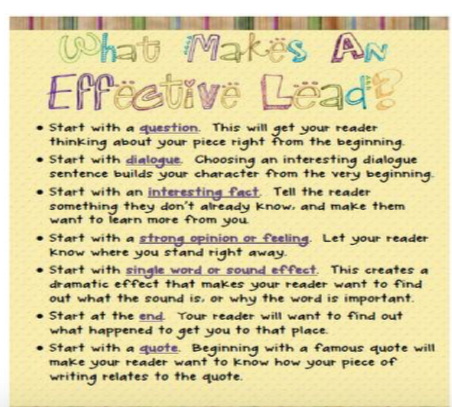
Strategies for Elaborating on Important Parts
-Slow down the action, telling it bit-by-bit
-Add dialogue
-Give details
-Show small actions
-Add internal thinking
-Slow down the action, telling it bit-by-bit
-Add dialogue
-Give details
-Show small actions
-Add internal thinking
| engagingleads.pdf | |
| File Size: | 1525 kb |
| File Type: | |
CRACKING OPEN TIRED WORDS AND PHRASES:
I can paint a picture in my reader’s mind by cracking Open Words/Creating my Own Thesaurus
Link: Writers want to crack open words in order to get to beautiful, hidden crystal. Words like fun, nice, pretty, wonderful and scary are generic, tired and overused words. They don’t say anything specific. They don’t paint a picture in the reader’s mind. We want to wake up these tired words. We can crack open sentences to change the tone. We can add concrete description in order to bring the writing alive. In each case, cracking open the known reveals the unknown. And, in most cases, it leads to something better, more exciting, more useful, more colorful, more surprising. Often in our manuscripts—especially early drafts—we may have non-descriptive words, phrases, and sentences that need to be cracked open and elaborated to really get to the good part. Consider these rather boring sentences:
· It was a pretty morning.
· He was a good boy.
· The food was good.
These are all telling sentences and we know that good writing shows and does not tell. And even though they tell, they sure don't tell much. The reader is left with questions and uncertainty because of a lack of details. When we crack open words and phrases we're trying to get to the show of the sentence. The process is easy. When you find a word, phrase, or sentence that tells, stop; envision the person, place, or thing; and give words to what you see in your mind. Then use the words that describe what you envision as you rewrite. Let me show you some examples and let you practice a couple of examples, too.
Word/Phrase/Sentence
What I Envision
Cracked Open Rewrite
It was a pretty morning.
· Sun/clouds
· Palms/sway
The palms swayed as the sun rose in the cloudy sky.
He was a good boy.
· Trevor
· A boy scout
· Trustworthy
Trevor was as good as a boy scout (and just as trusthworthy).
Teach: fun (adjective). Amusing, merry, enjoyable, lively, pleasant, diverting, festive, delightful
Fun (noun). Ball, blast, enjoyment, escapade, frolic, high jinks, merriment, recreation, romp, treat, merrymaking, horseplay, game, festivity, delight, entertainment
Thing: object, material, item, tool, utensil
Smile: beam, grin, laugh, smirk, glow
Walk: hike, stroll, step, stride, plod, stomp, glide, gallop, trudge, trample
Independent:
Crack open at least one sentence. Use a post it to create interesting one.
Begin your own personal thesaurus (word treasury) by finding at least two tired over used phrases/words and begin listing alternative words/phrases. (You may use a thesaurus).
Try re-visiting your own pieces and cracking open sentences and words that are overused and fixing them.
Begin collecting your own word treasury and keeping in your notebooks:
Words you love the sound of
Don’t know the meaning of but would like to find out
Words you have seen in books that look interesting
Words that give a strong image
Words that evoke a memory
Words you love to say out loud
Words that have special meaning
Try using them in your own writing (see if they make sense).
Also, try keeping a list of words you over use and find alternatives. Use a thesaurus and your imagination.
Ex: nice—sweet, friendly, appealing, kind, gracious, caring, empathic, docile, delightful, delicious
Beautiful- handsome, lovely, graceful, exquisite, elegant, delicate, radiant, charming, beaming
Revisit writing--
· find tired, over used words/phrases
· words with no images
· vague
· overly used they have lost meaning
· obvious words
· clichés
Replace with:
· specific, picture painting language that provides strong images
· use sensory imagery and details to describe stretched moments
· use a thesaurus to use a more unusual, different word
· words that have special/personal meaning
· may evoke memory in your mind and leave a mark/memory in the reader’s mind
Link: Writers want to crack open words in order to get to beautiful, hidden crystal. Words like fun, nice, pretty, wonderful and scary are generic, tired and overused words. They don’t say anything specific. They don’t paint a picture in the reader’s mind. We want to wake up these tired words. We can crack open sentences to change the tone. We can add concrete description in order to bring the writing alive. In each case, cracking open the known reveals the unknown. And, in most cases, it leads to something better, more exciting, more useful, more colorful, more surprising. Often in our manuscripts—especially early drafts—we may have non-descriptive words, phrases, and sentences that need to be cracked open and elaborated to really get to the good part. Consider these rather boring sentences:
· It was a pretty morning.
· He was a good boy.
· The food was good.
These are all telling sentences and we know that good writing shows and does not tell. And even though they tell, they sure don't tell much. The reader is left with questions and uncertainty because of a lack of details. When we crack open words and phrases we're trying to get to the show of the sentence. The process is easy. When you find a word, phrase, or sentence that tells, stop; envision the person, place, or thing; and give words to what you see in your mind. Then use the words that describe what you envision as you rewrite. Let me show you some examples and let you practice a couple of examples, too.
Word/Phrase/Sentence
What I Envision
Cracked Open Rewrite
It was a pretty morning.
· Sun/clouds
· Palms/sway
The palms swayed as the sun rose in the cloudy sky.
He was a good boy.
· Trevor
· A boy scout
· Trustworthy
Trevor was as good as a boy scout (and just as trusthworthy).
Teach: fun (adjective). Amusing, merry, enjoyable, lively, pleasant, diverting, festive, delightful
Fun (noun). Ball, blast, enjoyment, escapade, frolic, high jinks, merriment, recreation, romp, treat, merrymaking, horseplay, game, festivity, delight, entertainment
Thing: object, material, item, tool, utensil
Smile: beam, grin, laugh, smirk, glow
Walk: hike, stroll, step, stride, plod, stomp, glide, gallop, trudge, trample
Independent:
Crack open at least one sentence. Use a post it to create interesting one.
Begin your own personal thesaurus (word treasury) by finding at least two tired over used phrases/words and begin listing alternative words/phrases. (You may use a thesaurus).
Try re-visiting your own pieces and cracking open sentences and words that are overused and fixing them.
Begin collecting your own word treasury and keeping in your notebooks:
Words you love the sound of
Don’t know the meaning of but would like to find out
Words you have seen in books that look interesting
Words that give a strong image
Words that evoke a memory
Words you love to say out loud
Words that have special meaning
Try using them in your own writing (see if they make sense).
Also, try keeping a list of words you over use and find alternatives. Use a thesaurus and your imagination.
Ex: nice—sweet, friendly, appealing, kind, gracious, caring, empathic, docile, delightful, delicious
Beautiful- handsome, lovely, graceful, exquisite, elegant, delicate, radiant, charming, beaming
Revisit writing--
· find tired, over used words/phrases
· words with no images
· vague
· overly used they have lost meaning
· obvious words
· clichés
Replace with:
· specific, picture painting language that provides strong images
· use sensory imagery and details to describe stretched moments
· use a thesaurus to use a more unusual, different word
· words that have special/personal meaning
· may evoke memory in your mind and leave a mark/memory in the reader’s mind
WRITING OFF A SIGNIFICANT OBJECT:
Connect: Just like in Tackle Box where Ralph Fletcher wrote a narrative off something special that brought back memorable moments, we have objects that hold special meaning to us. They can give us good ideas for writing.
Teach: Notice what I do as I describe my special object or special friend, Mrs. Beasley:
1. Describe what she looks like using picture painting language and figurative language
2. feelings
3. how I got her
4. Setting
Repeated refrain
Use both dialogue and internal thinking
Slow down the action
Use third person or first-second person
***MAKE SURE THE MESSAGE-BIG IDEA THAT YOU WANT TO EXPRESS WITH YOUR READER IS CLEARLY EVIDENT THROUGHOUT YOUR PIECE-ENTRY.
Teach: Notice what I do as I describe my special object or special friend, Mrs. Beasley:
1. Describe what she looks like using picture painting language and figurative language
2. feelings
3. how I got her
4. Setting
Repeated refrain
Use both dialogue and internal thinking
Slow down the action
Use third person or first-second person
***MAKE SURE THE MESSAGE-BIG IDEA THAT YOU WANT TO EXPRESS WITH YOUR READER IS CLEARLY EVIDENT THROUGHOUT YOUR PIECE-ENTRY.
| the_tackle_box_1.pdf | |
| File Size: | 441 kb |
| File Type: | |
| |||||||
EXTENDED METAPHOR ACTIVITY--PUBLISH YOUR OWN EXTENDED METAPHOR WITH IMAGES AND CORRECT FORMAT BY MONDAY, OCTOBER 22. EXTENDED METAPHOR TASK:
FIGHT SONG-THINK ABOUT THE OVERALL MESSAGE. WHAT IS THIS SONG REALLY ABOUT? HOW DO YOU KNOW?
Fight Song
Rachel Platten
Like a small boat
On the ocean
Sending big waves
Into motion
Like how a single word
Can make a heart open
I might only have one match
But I can make an explosion
And all those things I didn't say
Wrecking balls inside my brain
I will scream them loud tonight
Can you hear my voice this time?
This is my fight song
Take back my life song
Prove I'm alright song
My power's turned on
Starting right now I'll be strong
I'll play my fight song
And I don't really care if nobody else believes
'Cause I've still got a lot of fight left in me
Losing friends and I'm chasing sleep
Everybody's worried about me
In too deep
Say I'm in too deep (in too deep)
And it's been two years I miss my home
But there's a fire burning in my bones
Still believe
Yeah, I still believe
And all those things I didn't say
Wrecking balls inside my brain
I will scream them loud tonight
Can you hear my voice this time?
This is my fight song
Take back my life song
Prove I'm alright song
My power's turned on
Starting right now I'll be strong
I'll play my fight song
And I don't really care if nobody else believes
'Cause I've still got a lot of fight left in me
A lot of fight left in me
Like a small boat
On the ocean
Sending big waves
Into motion
Like how a single word
Can make a heart open
I might only have one match
But I can make an explosion
This is my fight song
Take back my life song
Prove I'm alright song
My power's turned on
Starting right now I'll be strong (I'll be strong)
I'll play my fight song
And I don't really care if nobody else believes
'Cause I've still got a lot of fight left in me
Know I've still got a lot of fight left in me
Rachel Platten
Like a small boat
On the ocean
Sending big waves
Into motion
Like how a single word
Can make a heart open
I might only have one match
But I can make an explosion
And all those things I didn't say
Wrecking balls inside my brain
I will scream them loud tonight
Can you hear my voice this time?
This is my fight song
Take back my life song
Prove I'm alright song
My power's turned on
Starting right now I'll be strong
I'll play my fight song
And I don't really care if nobody else believes
'Cause I've still got a lot of fight left in me
Losing friends and I'm chasing sleep
Everybody's worried about me
In too deep
Say I'm in too deep (in too deep)
And it's been two years I miss my home
But there's a fire burning in my bones
Still believe
Yeah, I still believe
And all those things I didn't say
Wrecking balls inside my brain
I will scream them loud tonight
Can you hear my voice this time?
This is my fight song
Take back my life song
Prove I'm alright song
My power's turned on
Starting right now I'll be strong
I'll play my fight song
And I don't really care if nobody else believes
'Cause I've still got a lot of fight left in me
A lot of fight left in me
Like a small boat
On the ocean
Sending big waves
Into motion
Like how a single word
Can make a heart open
I might only have one match
But I can make an explosion
This is my fight song
Take back my life song
Prove I'm alright song
My power's turned on
Starting right now I'll be strong (I'll be strong)
I'll play my fight song
And I don't really care if nobody else believes
'Cause I've still got a lot of fight left in me
Know I've still got a lot of fight left in me
| extendedmetaphor4315.doc | |
| File Size: | 995 kb |
| File Type: | doc |
| metaphor_poems.pdf | |
| File Size: | 241 kb |
| File Type: | |
Writing workshop: Writing extended metaphor. How can we write extended metaphors? By writing extended metaphors, students will use sensory details to convey experiences and events precisely. .
TASKS:
- Write a new entry in your notebook that incorporate metaphors or extended metaphors..
- WRITE YOUR OWN EXTENDED METAPHOR THAT INCORPORATES THE STRATEGIES WE HAVE BEEN UTILIZING IN CLASS. PUBLISH WITH IMAGES, CORECT FORMAT-COLUMNS BY MONDAY, OCTOBER 21ST. FIRST DRAFT IS DUE THURSDAY, OCTOBER 17TH OR SOONER.
STRATEGIES TO ASSIST THAT WE WORKED ON IN CLASS: We practiced writing a description of someone or something using this device. For example, if you want to say my dad is my teddy bear. You can go on to say things like he wraps his big arms around me. I love hugging him. He feels soft and warm. When I am sad, I can look into his big brown eyes and feel secure. He laughs heartedly from his round belly that protrudes slightly from his pants and that makes me smile.
IF YOU NEED PRACTICE, TRY THIS FIRST:
Practice writing your own extended metaphor. We can then publish—with illustrations-images.
If you are still having trouble with metaphors, they can do this section: REMEMBER: A METAPHOR IS A FIGURE OF SPEECH THAT COMPARES TWO DIFFERENT THINGS WITHOUT USING A WORD OF COMPARISON SUCH AS LIKE OR AS. STEPS TO HELP YOU WRITE A METAPHOR:
- CHOOSE A NOUN.
- ASK YOURSELF, “WHAT DIFFERENT THIGS CAN I COMPARE IT TO?”
- WRITE YOUR METAPHOR.
- FOR EXAMPLE: NOUN: UMBRELLA. I WILL COMPARE IT TO A ROOF. THE UMBRELLA WAS A ROOF OVER MY HEAD
- NOW YOU TRY IT:
- Pick a noun.
- Compare it to ______________________
- Write your metaphor. ___________________
- The sergeant barked commands to his men.
- The farmer disliked the roar of city streets.
- My mother is an angel.
- The student sailed through the test.
Now> Write at least five original sentences that contain metaphors. You may choose from the suggestions below or come up with your own ideas:
- A sentence describing how your father looked when he found out you had lost his favorite book
- A sentence describing an exciting moment in a baseball or football game
- A sentence describing a teacher facing an unruly class
- A sentence describing your best friend’s face
- A sentence telling how you felt when you found out you had failed a test.
FIGURATIVE LANGUAGE POWERPOINT: PLEASE REVIEW AND USE A GOOD DEAL OF DESCRIPTIVE & FIGURATIVE LANGUAGE ALONG WITH SENSORY IMAGERY IN YOUR WRITING
| figurative-language_power_point_1__2_.ppt | |
| File Size: | 2248 kb |
| File Type: | ppt |
ANGEL STATIONERY:
| angel-stationery.pdf | |
| File Size: | 692 kb |
| File Type: | |
CAPITALIZATION POWERPOINT: PLEASE REVIEW...THIS WILL HELP YOU...I PROMISE... AS YOU DECIDE WHICH NOUNS TO CAPITALIZE...
| capitalization.ppt | |
| File Size: | 1657 kb |
| File Type: | ppt |
BIO POEM--PUBLISH BY THIS FRIDAY, SEPTEMBER 14
| how_to_write_a_biopoem.doc | |
| File Size: | 32 kb |
| File Type: | doc |
| bio_poem_rubric[1].doc | |
| File Size: | 31 kb |
| File Type: | doc |
THE WRITER'S NOTEBOOK:
IT'S A PLACE TO:
THINK OUT LOUD
DREAM
SCHEME
ASK QUESTIONS
WONDER
WANDER
PLAN
OBSERVE
IMAGINE
DESCRIBE
EXPLAIN
CREATE
SHARE
CARE
COLLECT
RESPOND
THINK OUT LOUD
DREAM
SCHEME
ASK QUESTIONS
WONDER
WANDER
PLAN
OBSERVE
IMAGINE
DESCRIBE
EXPLAIN
CREATE
SHARE
CARE
COLLECT
RESPOND
| writersnotebook.doc | |
| File Size: | 85 kb |
| File Type: | doc |
RULES:1. Save everything, it’s all part of the history of the piece of writing, plus you never know what you might want to come back to later and use.
2. Date and label everything you write to keep track of what you’ve done.
3. Write on one side of the paper only, and always double space. Both will make revision, polishing, and editing easier and more productive.
4. Draft your writing in sentences and paragraphs.
5. Get into the habit of punctuating and spelling as well as you can while you’re composing.
6. Understand that writing is thinking. Do nothing to distract the other writers. Don’t put your words into our brains as we’re struggling to find our own. Instead, find your private, internal writing place, lock the door and listen to your voice.
7. Whisper when conferencing with teacher and peers.
8. Use the conference area for peer conferencing, and complete the Peer Conferencing Sheet so the writer has a record of what was discussed and can form a plan of action.
9. When you’re stuck or uncertain, use the resources available to you in this room, including your writing notes and your lists of writing topics, and tap the techniques you’ve been shown in conferences and mini-lessons.
10. Everything you intend to publish needs revision. One draft is never enough.
11. Self-edit as completely as you can in a different colour, and complete an editing checklist to show what you know about conventions of writing.
12. When a piece of writing is finished, clip or staple everything together, including drafts, notes, lists, editing checklist, and peer conference form. File it in the publish section of your binder, with the final copy on top.
13. Write as well and as much as you can, and work hard; dedication makes a good writer.
2. Date and label everything you write to keep track of what you’ve done.
3. Write on one side of the paper only, and always double space. Both will make revision, polishing, and editing easier and more productive.
4. Draft your writing in sentences and paragraphs.
5. Get into the habit of punctuating and spelling as well as you can while you’re composing.
6. Understand that writing is thinking. Do nothing to distract the other writers. Don’t put your words into our brains as we’re struggling to find our own. Instead, find your private, internal writing place, lock the door and listen to your voice.
7. Whisper when conferencing with teacher and peers.
8. Use the conference area for peer conferencing, and complete the Peer Conferencing Sheet so the writer has a record of what was discussed and can form a plan of action.
9. When you’re stuck or uncertain, use the resources available to you in this room, including your writing notes and your lists of writing topics, and tap the techniques you’ve been shown in conferences and mini-lessons.
10. Everything you intend to publish needs revision. One draft is never enough.
11. Self-edit as completely as you can in a different colour, and complete an editing checklist to show what you know about conventions of writing.
12. When a piece of writing is finished, clip or staple everything together, including drafts, notes, lists, editing checklist, and peer conference form. File it in the publish section of your binder, with the final copy on top.
13. Write as well and as much as you can, and work hard; dedication makes a good writer.
EXPECTATIONS & RULES FOR WRITING WORKSHOP & LEADING A WRITERLY LIFE:
MOST IMPORTANT: Carry your notebook with you at all times. You never know when you will be inspired to jot down your story ideas or observations.
EXPECTATIONS:
1. Find topics and purposes for your writing that matter to you, your life, who you are, and whom you want to become.
2. Keep a list of your possible topics as a writer.
3. Try new topics, purposes, audiences, genres, forms, and techniques.
4. Make your own decisions about what’s working and what needs more work in pieces of your writing. Be the first responder to your writing, and read yourself with a critical, literary eye and ear.
5. Listen and ask questions about and comment on others’ writing in ways that help them improve their writing.
6. Take notes of information presented in writing mini-lessons, recorded chronologically.
7. Recognize that readers’ eyes and minds need your writing to be conventional in format, spelling, punctuation, and usage. Work toward conventionality and legibility, and use everything you know about format, spelling, punctuation, and usage as you compose.
8. Take care of the writing materials and resources.
9. Each day, establish and work toward significant, relevant goals for yourself as a writer.
10. In every writing workshop, take a deliberate stance toward writing well: try to make your writing effective and use what you’ve been shown in conferences and mini-lessons to help you get there.
11. Work hard in writing workshop. Remain focused and on task during class.
1. Find topics and purposes for your writing that matter to you, your life, who you are, and whom you want to become.
2. Keep a list of your possible topics as a writer.
3. Try new topics, purposes, audiences, genres, forms, and techniques.
4. Make your own decisions about what’s working and what needs more work in pieces of your writing. Be the first responder to your writing, and read yourself with a critical, literary eye and ear.
5. Listen and ask questions about and comment on others’ writing in ways that help them improve their writing.
6. Take notes of information presented in writing mini-lessons, recorded chronologically.
7. Recognize that readers’ eyes and minds need your writing to be conventional in format, spelling, punctuation, and usage. Work toward conventionality and legibility, and use everything you know about format, spelling, punctuation, and usage as you compose.
8. Take care of the writing materials and resources.
9. Each day, establish and work toward significant, relevant goals for yourself as a writer.
10. In every writing workshop, take a deliberate stance toward writing well: try to make your writing effective and use what you’ve been shown in conferences and mini-lessons to help you get there.
11. Work hard in writing workshop. Remain focused and on task during class.
